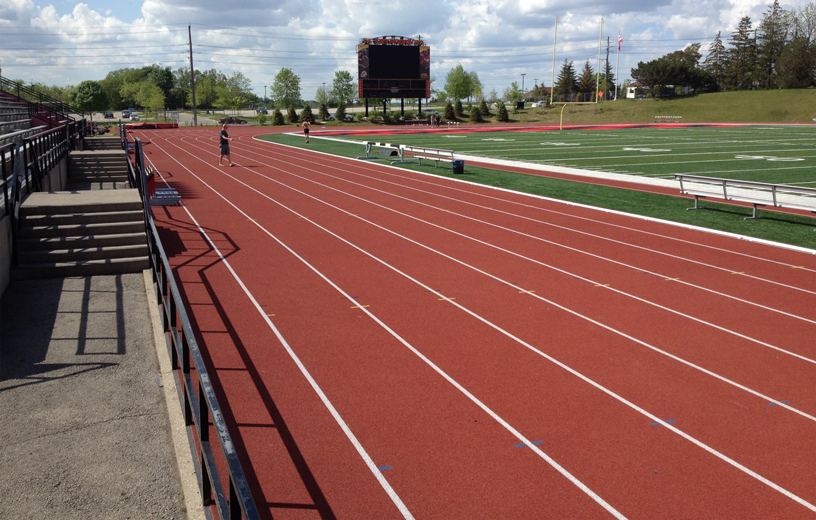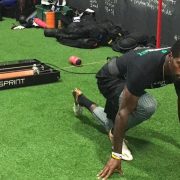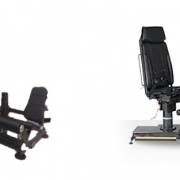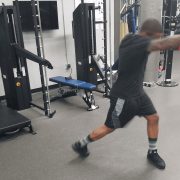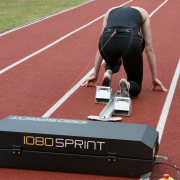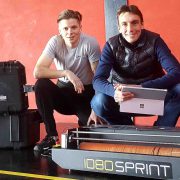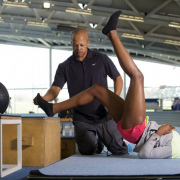“Negative results” should be an oxymoron, the sort of throwback phrase you use ironically to get a smug chuckle at the expense of earlier generations. But somehow the idea still has purchase around the scientific community.
Not at the University of Guelph’s Human Performance and Health Research Laboratory. Dr. Jamie Burr and HPL graduate student Rachel Aubry are on the list of “5 Sports Science Studies that ‘Failed.’” The latest publication out of the HPL may someday share a similar distinction, with its behind-the-scenes story featuring lessons that may be more exciting than what appears in the journal article.
Kyle Thompson is the first author of a study in the Journal of Strength and Conditioning Research that used the 1080 Sprint in a post-activation potentiation (PAP) protocol. Thompson set out to investigate resisted sprinting as a means to induce PAP. The athletes all ran five 20-meter sprints. The first and last sprints had only the nominal 1-kilogram resistance necessary to keep tension on the tow cable and collect data. Those in the experimental group ran the middle three sprints with the 1080 Sprint providing resistance of 45% body mass. The control group performed those sprints unresisted.
Thompson chose to study sprinters from the University of Guelph track & field team because they would produce the most consistent performance across the trials. They conducted the study during track season to ensure maximal effort at or near peak ability. “This is their sport, so we could feel more confident in what they are giving us,” Thompson said.
He was right about that. The average coefficient of variation for the 20 sprinters was ~2% over 5 and 20 meters: about .04 seconds.
This level of confidence in their performance translated to confidence in the rest of his findings. With such a small amount of variation in performance, any effect in the experimental trials could be attributed to the intervention. But there was no such effect.
“With this paper in the mix alongside a few others that have similar study aims, I think we can conclude there is a minimum amount of resistance necessary to give you a PAP effect.”
“At the same time, though, from what I’ve experienced and from watching the team, I’m not sure that load is as important as we make it out to be. We’re only really talking about load because no one is going in other directions.” That is, towards using overspeed or volume to create the overload for post-activation potentiation.
Thompson was thinking particularly about the after-hours work he and two others did with the 1080 Sprint during the study. This unofficial trio performed 20 sprints, with the same 45% body mass loading and the same 5-minute rest period as the study. All three had the same subjective experience and quantitative response.
“After 6-8 sprints with load we all got tired. We felt like dying and we were ready to throw up and thought we would have to stop before we reached 20. But by the 11th or 12th sprint we were running faster than we were on the first five.”
The good times only lasted for 2-3 more sprints, and then overall performance declined for the remainder of the 20 trials.
“Maybe it’s PAP or some kind of super-compensation, maybe we just needed to be fully warmed up. You could argue we are not good at perceiving whether we are tired because so many factors go into it. We may have felt tired, and perceived the stress to be greater than it really was. Meanwhile, we were not muscularly fatigued.”
With velocity and volume in the mix as the potentiating stimuli, Thompson points out the growing need for individually profiling the athlete and the event. Coaches must assess the athlete and the session (training or competition) to determine what they want to potentiate. Wrapped around that question is whether the coach should potentiate an athlete’s weaker areas to minimize their deficiencies, or their stronger areas to make the most out of their best attributes. That, in turn, requires a detailed knowledge and rigorous framework to make those assessments. And with all that in mind, they choose the attribute to overload and the means to do so.
“So much depends on what we are trying to get out of the run. I’ve seen really heavy loads used, but it throws off the mechanics of the sprint. Depending on who I’m working with I may not want to sacrifice mechanics for power.
The Band is back together off the holiday break. Getting our accel game straight with @1080motion resisted runs. @Gryphontrack #2018 pic.twitter.com/QVbwJnHUs3
— Jason Kerr (@kerrjason) January 4, 2018
“To have that magic training formula, I think the question becomes more focused around assessing the strengths and deficiencies of the athlete, and then knowing what and when to focus on developing different athletic qualities. Suggesting what loads, velocities or volumes a certain athlete – specifically quality sprinters – should be using to get faster based on the results of our study would be a little like saying everyone on the highway should drive at one given speed because that’s when the fewest accidents occur. It’s just not that simple.
“I think what we can take away from our study findings, the behind-the-scenes work and previous literature is that there are styles of training that allow athletes to see immediate improvements in performance metrics. Finding each athlete’s PAP recipe is more challenging when controlling for one variable at a time. But I am excited with the abundance of ‘sprint screening’ research that has been coming out lately and believe this work and the work of others will give coaches a good starting point when trying to establish individualized performance based warm-up protocols.
“It all gets into the logistics of performance studies and how those prepare you to make it happen in an applied setting. How much work is enough work? How do you apply the factors that we control?”
